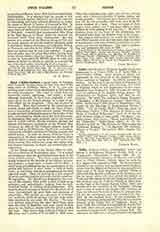

Coeur d’Alene Indians, a small tribe of Salishan stock formerly ranging along the lake and river of the same name in Northern Idaho, U.S.A., and now residing upon a reservation established in 1873 within the same boundaries. The name by which they are commonly known, signifying “awl heart”, is said, although doubtfully, to have been originally a nick-name given by the French traders to a chief of the tribe noted for his stinginess. They call themselves Skitswish. When first noticed by the American explorers, Lewis and Clark, in 1805, the Coeur d’Alene were a wandering, poverty-stricken people, dwelling in mat-covered communal houses on the border of the lake, and subsisting chiefly upon fish and wild roots. In disposition they were peaceful, brave and honest, and at a later period, having acquired through the French and Iroquois employees of the Hudson Bay Company an idea of the Catholic religion, many of them, as well as the Flatheads, Nez Perces, and others, voluntarily adopted a system of Christian prayers and church forms. In 1841 the Jesuit, Nicholas Point, a companion of De Smet, established the Sacred Heart (now De Smet) mission among them, with such wonderful success that within ten years the entire tribe had become Christian, civilized, and comfortably self-supporting.
In his official report to the Indian Office in 1854, Governor Stevens of Washington says: “It is indeed extraordinary what the good fathers have done at the Coeur d’Alene mission. They have a splendid church nearly finished by the labors of the fathers, laymen, and Indians; a large barn; a horse mill for flour; a small range of buildings for the accommodation of the priests and laymen; a store room; a milk or dairy room; a cook room, and good arrangements for their pigs and cattle. They are putting up a new range of quarters, and the Indians have some twelve comfortable log cabins. The church was designed by the superior of the mission, Pere Avile, a man of skill as an architect, and undoubtedly, judging from his well-thumbed books, of various accomplishments. Pere
Gazzoli showed me several designs for the altar, all of them characterized by good taste and harmony of proportion. The church, as a specimen of architecture, would do credit to anyone, and has been faith-fully sketched by our artist, Mr. Stanley. The massive timbers supporting the altar were from larch trees five feet in diameter, and were raised to their place by the Indians, simply with the aid of a pulley and rope. They have a large cultivated field of some 200 acres, and a prairie of from 2000 to 3000 acres.
They own a hundred pigs, eight yoke of oxen, twenty cows, and a liberal proportion of horses, mules, and young animals. The Indians have learned to plough, sow, till the soil generally, milk cows, and do all the duties incident to a farm. They are some of them expert wood cutters, and I saw some thirty or forty Indians at work getting in the harvest.” All this in thirteen years in the heart of the wilderness, two thousand miles from the frontier town of St. Louis!
The mission still continues to mould the tribal life, and official reports show that the same high standard is maintained, each year showing an advance in prosperity and general intelligence. The tribe is increasing, and numbered 492 souls in 1906.
JAMES MOONEY

